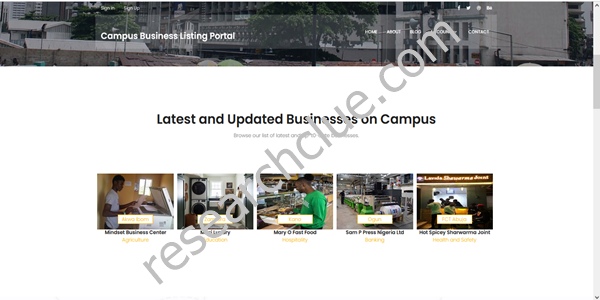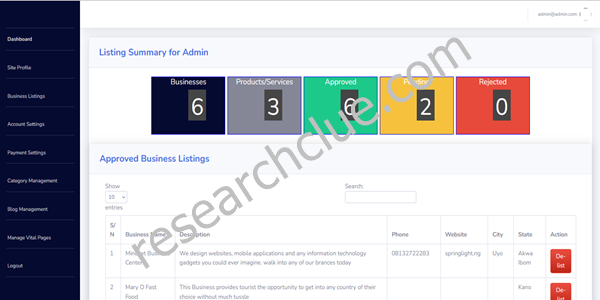ABSTRACT
The paper examines the Design and Implementation of Campus Business Listing Management System (A case study of University of Lagos). Considering the numerous challenges campuses face in advertising goods and services offered to campuses to students and lecturers in an effective manner, the paper aims at developing a secure and convenient management system where students and other vendors on campuses can showcase their products in real time. Considering technology used in implementing this work, the researcher used HTML, CSS, SQL and PHP. These technologies were considered because of its robust and simplicity in solving complex issues faced by many campuses in Nigeria.
CHAPTER ONE
INTRODUCTION
1.1 Background to the Study
In the digital age, the management of campus businesses has become increasingly intricate, necessitating innovative solutions to streamline operations and enhance visibility. The emergence of online platforms has revolutionized the way businesses operate, presenting opportunities for efficient management and marketing. This necessitates the development of comprehensive systems tailored to the unique needs of campus environments. The Design and Implementation of an Online Campus Business Listing Management System serves as a solution to these challenges, providing a centralized platform for businesses within a campus ecosystem to effectively manage their listings, enhance their online presence, and engage with the campus community (Brown & White 2020).
The proposed system aims to address the inherent complexities associated with managing business listings within a campus environment. By leveraging technology, it offers a user-friendly interface that allows businesses to create, update, and maintain their listings with ease. Additionally, the system provides features such as search functionality, categorization, and interactive maps, enabling users to discover and engage with campus businesses effortlessly. Through effective design and implementation, the system enhances accessibility, fosters community engagement, and promotes economic growth within the campus ecosystem (Agile Alliance, 2023).
To ensure the effectiveness and reliability of the system, it is imperative to draw upon established methodologies and best practices in software design and development. Incorporating elements of user-centered design, agile development, and robust testing procedures will be essential in creating a system that meets the diverse needs of stakeholders while ensuring scalability and maintainability. Furthermore, the utilization of modern technologies and frameworks will empower the system to adapt to evolving requirements and technological advancements, ensuring its longevity and relevance in the ever-changing landscape of campus business management (Smith & Jones, 2016).
1.2 Statement of the Problem
Managing campus businesses efficiently presents a significant challenge due to the lack of centralized platforms tailored to the unique needs of the campus environment. Existing systems often lack features crucial for effective business management, such as comprehensive listing management, interactive user interfaces, and integration with campus-specific services. Consequently, businesses within the campus ecosystem face hurdles in maintaining an online presence, attracting customers, and engaging with the campus community. This fragmentation not only impedes the growth of campus businesses but also hampers the overall economic vibrancy of the campus environment.
Moreover, the absence of a standardized platform for business listing management complicates the process of discovering and accessing campus services for students, faculty, and visitors alike. Without a centralized system, users must navigate disparate websites, physical notices, and word-of-mouth recommendations to identify relevant businesses and services within the campus vicinity. This lack of cohesion not only results in a suboptimal user experience but also diminishes the visibility and viability of campus businesses. Thus, there is a pressing need for the design and implementation of an Online Campus Business Listing Management System to address these challenges and foster a thriving, interconnected campus business ecosystem (Gamma et al, 2019).
1.3 Objectives of the Study
The main objective of the study is to examine Design and Implementation of Campus Business Listing Management System (A case study of University of Lagos). Specific objectives of the study are:
- To design a well-structured and optimized database management system to store, process and retrieve user and business information in real-time.
- To design and Implement a fast and secure business listing portal that can accommodate all businesses on campus.
- To create a fast query system where customers can search for businesses within their campus in real-time.
- To create an ecosystem for businesses, students and lecturers within the campus.
- To proffer solutions to the challenges and enhance already existing systems in place.
SCREEN SHOTS OF THE APPLICATION


1.4 Significance of the Study
The study is important for many reasons. The following are the major stakeholders this paper through its practical and theoretical implications and findings will be of great significance:
Firstly, the paper will benefit major stakeholders and policy makers in the Information Technology sector. The various analysis, findings and discussions outlined in this paper will serve as a guide in enabling major positive changes in the industry and sub-sectors.
Secondly, the paper is also beneficial to the organizations used for the research. Since first hand data was gotten and analysed from the organization, they stand a chance to benefit directly from the findings of the study in respect to their various organizations. These findings will fast track growth and enable productivity in the organisations used as a case study.
Finally, the paper will serve as a guide to other researchers willing to research further into the subject matter. Through the conclusions, limitations and gaps identified in the subject matter, other student and independent researchers can have a well laid foundation to conduct further studies.
1.7 Scope of the Study
The study is delimited to the University of Lagos Campus. Findings and recommendations from the study reflects the views and opinions of respondents sampled in the area. It may not reflect the entire picture in the population.
1.8 Limitations of the Study
The major limitations of the research study are time, financial constraints and delays from respondents. The researcher had difficulties combining lectures with field work. Financial constraints in form of getting adequate funds and sponsors to print questionnaires, hold Focus group discussions and logistics was recorded. Finally, respondents were a bit reluctant in filling questionnaires and submitting them on time. This delayed the project work a bit.
1.9 Organization of the Study
The study is made up of five (5) Chapters. Chapter one of the study gives a general introduction to the subject matter, background to the problem as well as a detailed problem statement of the research. This chapter also sets the objectives of the paper in motion detailing out the significance and scope of the paper.
Chapter Two of the paper entails the review of related literature with regards to corporate governance and integrated reporting. This chapter outlines the conceptual reviews, theoretical reviews and empirical reviews of the study.
Chapter three focuses on the methodology and analysis of the existing system. This gives an insight into the analysis of systems in place already, facts finding sources, input analysis, output analysis, process analysis and objectives of the new system to be implemented.
Chapter Four focuses on the Analysis of the New system to be Implemented, the design standard, output specification and design, input specification and design, system flow chart and requirements.
Chapter Five outlines the findings, conclusions and recommendations of the study. Based on objectives set out, the researcher concludes the paper by answering all research questions set out in the study.
1.10 Definition of Terms
- Online Campus Business Listing Management System: A software platform designed to centralize and streamline the management of business listings within a campus environment. This system enables businesses to create, update, and maintain their listings online, facilitating easier access and engagement for students, faculty, and visitors.
- Campus Business: Any business entity operating within the premises of an educational institution, including but not limited to cafes, bookstores, printing services, and fitness centers.
- Listing Management: The process of creating, editing, organizing, and updating business listings, including information such as business name, contact details, operating hours, location, and services offered.
- User Interface (UI): The graphical interface through which users interact with the online platform. This includes elements such as menus, forms, buttons, and navigation controls, designed to facilitate user interaction and task completion.
- User Experience (UX): The overall experience of users as they interact with the online platform, encompassing aspects such as ease of use, accessibility, responsiveness, and satisfaction. A positive UX enhances user engagement and encourages repeat usage of the system.
- Integration: The process of combining different software components or systems to work together seamlessly. Integration in the context of an Online Campus Business Listing Management System involves connecting with existing campus databases, services, and platforms to enhance functionality and interoperability.
- Search Functionality: The capability of the system to allow users to search and discover businesses based on specific criteria such as business name, location, category, or services offered. Effective search functionality improves the efficiency of users in finding relevant information within the platform.
- Scalability: The ability of the system to accommodate increasing demands and workload without compromising performance or functionality. A scalable system can handle growing numbers of users, businesses, and listings while maintaining optimal performance levels.
- Maintenance: The ongoing process of monitoring, updating, and optimizing the system to ensure its continued functionality, security, and relevance. Regular maintenance activities are essential to address bugs, implement enhancements, and adapt to changing requirements and technologies.
